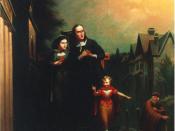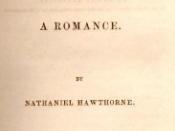In "The Scarlet letter" Nathaniel Hawthorne writes about sin, the nature of evil, an individual's identity in society and the human condition by weaving all of these conditions in to his characters and thereby creating the plot in his novel. In his novel Hawthorne uses the repressive, authoritarian puritan society as an analogue for human kind in general. The puritan setting also enables Hawthorne to portray the human soul under extreme pressure. In the Scarlet Letter characters such as Hester, Dimmesdale and Chillingworth while part of the puritan society in which they live, also reflect experiences relating to today's societies. Hawthorne as a descendent of the puritans where his grand farther and great grand farther were puritan judges is haunted by his puritan ancestry where he states that their lives are defined by strict definitions of sin and guilt. As a descendent of judges and magistrates who had handed down the same kind of punishment suffered by Hester Prynne, Hawthorne feels implicated in someway in the puritan traditions he criticizes.
In the Scarlet Letter Hawthorne seems to be stating his feelings about his puritan ancestry through the narrator. This is evident through the narrators statements such as "the inner most me behind its vials". Hawthorne also examines puritan legacies such as the conflict between the individual and the church and the psychological aspects of good and evil. Hawthorne sees the puritan laws as unfair, accordingly in the Scarlet Letter Hawthorne calls in to question the key elements of puritan morality. Puritan laws are based upon sins and crimes committed against god, but in his description of Dimsdale, Hester and ChillingWorth, Hawthorne shifts the emphasis from sin to evil. In Hawthorne view sin is theological and requires a specific religious law to be broken, but evil on the...


